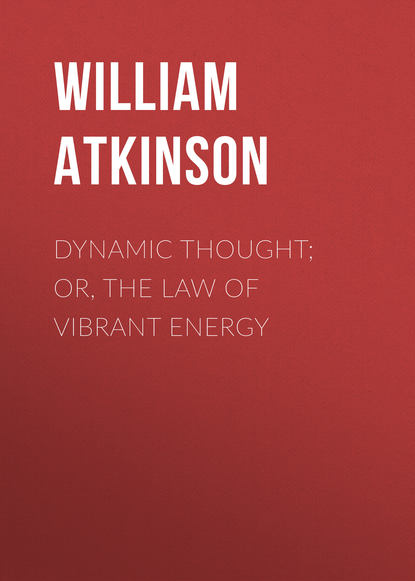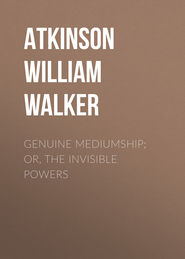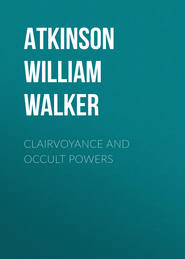По всем вопросам обращайтесь на: info@litportal.ru
(©) 2003-2024.
✖
Dynamic Thought; Or, The Law of Vibrant Energy
Настройки чтения
Размер шрифта
Высота строк
Поля
In the previous chapters we saw that the form of Attraction called "Cohesion" caused the molecules to tend to each other, and to remain in more or less close contact, the differing degrees of Cohesion determining the Density, etc., of the body. Were the Attractive force of Cohesion suddenly removed, the most solid bodies, as well as the lightest ones, would instantly fly into very fine powder, thus being resolved into their constituent molecules. The separation of the Molecules, that is, the "setting further apart," occasioned by Heat, is spoken of by Physicists as "Repulsion." But the writer holds that repulsion is an entirely different thing, and that the heat merely causes the Molecules to lose a portion of their Attractive power for each other. Until the heat being withdrawn, the Molecules respond to the uninterrupted Attraction. The Molecules are like lovers who are attracted toward each other, and remain attached unless separated violently, or by some fading of Attraction. Consider Heat as a disturbing element – a "misunderstanding" between the molecular lovers, who under its influence draw somewhat apart, and are only reunited when the obstacle is removed, and harmony again manifested.
As we have shown you in a previous chapter, the so-called "properties" of Matter, i. e., Hardness, Tenacity, Malleability, Ductility, etc., are simply evidence of a persistent Cohesiveness of the Molecules – a strong "love" or "desire" for each other that caused them to adopt every possible means in their power to resist, and prevent, the separation of the Molecules forming the mass. It was like a desperate attempt to prevent the "breaking up of the family."
Each so-called Special Physical Property of Matter is seen to be but the action of the Molecule resisting separation, in obedience to that law of its being called "Attraction," or "Gravitation," or "Cohesion," or "Adhesion" – but which might as fitly be called "Desire," or "Love." And, remember, that this law does not seem to be merely one of self-preservation of the Molecule – for it remains intact even after the separation from its companions or family. It is more, for it is a law that causes it to bend all its energies in remaining within "molecular distance" or close companionship with its family, and resisting disintegration. It is like the "social instinct" in Man, if one may be pardoned from using the figure.
Now for the Attraction of the Atoms – "Chemical Affinity," or "Chemism," as it is called. An Atom, you know, is the chemical unit of Matter, and the smallest particle of Matter that can enter into combination (leaving the Corpuscle out of the consideration, for the moment). These Atoms exhibit and manifest an Attraction for each other that causes them to form combinations or "marriages," and thus to combine, forming a molecule. But remember, always, that when Atoms "combine" they do not merge their identities – they simply "marry," and nothing more. Each atom maintains its own identity, and is found intact if the "marriage" is destroyed by chemical process, which might be called the termination of the molecular marriage, by "divorce," that is, by one Atom forsaking its mate and seeking a new "affinity" in the shape of some more attractive (or attracting) Atom. For, alas, the Atoms are more or less fickle, and often leave their life-partners for some other fascinating Particle. At times there is manifested a condition of "how happy could I be with either, were t'other fair charmer away" – there is a conflict of attractions.
There is more "flirting" and "affairs of the heart" in the world of Atoms than in the region of the Molecules, for while the latter are apt to seek only the companionship of their own "family," or some nearly related family, the Atoms have quite a number of possible "affinities," and will invariably desert a lesser attraction for a greater one (thus forming a new molecule) and leave the deserted one to get along alone as best it may, or else form a new alliance with some other affinity who is either impervious to the attraction of the more brilliant charmer, or else is out of the danger of temptation.
But, if we analyze and carefully consider this "Chemical Affinity," "Chemism," we will see that it comes well under the definition of "Attraction" as given by Webster, and quoted in the first part of this chapter. It certainly comes under the rule of "the power in nature acting mutually between bodies, or ultimate particles, tending to draw them together," etc.
The writer thinks that he is justified in asking you to consider Gravitation, Cohesion, Adhesion and Chemical Affinity as related forms of the same thing. If you do not like to call this "same thing" by the name of "Gravitation," suppose we call it "The Law of Attraction," of which Gravitation, Cohesion, Adhesion, Chemical Affinity or Chemism are but different aspects. (This "relation" is described in Chapter XIII.)
And the writer believes that this "Law of Attraction" is the underlying cause of all that we call Energy, Force, Power, Motion, etc., in the Physical world. For if "Gravitation" accounts for all "Mass Motion," or "Mechanical Motion" – if Molecular Cohesion, and the vibrations accompanying it, manifest in forms of "Molecular Motion" – and if Atomic "Chemical Affinity" or "Chemism," manifest in "Atomic Motion" – and if even the Corpuscles in their movements obey this same "Law of Attraction" in some form – and if all Force and Energy is but a "Mode of Motion" – then, if all this be true, are we not justified in claiming that this "Law of Attraction" is the Basis of All Energy, Force and Motion? And are we not justified in thinking of this "Law of Attraction" as always manifesting in the direction of drawing together particles of Substance – be those particles suns, planets, masses, molecules, atoms or corpuscles – in pursuance of some basic law imposed upon All-things, by That-which-is-above-Things?
The following quotation is interesting, in our consideration of this subject:
"There are other forces besides gravity, and one of the most active of these is chemical affinity. Thus, for instance, an atom of oxygen has a very strong attraction for one of carbon, and we may compare these two atoms to the earth and a stone lodged upon the top of a house. Within certain limits, this attraction is intensely powerful, so that when an atom of carbon and one of oxygen have been separated from each other, we have a species of energy of position just as truly as when a stone has been separated from the earth. Thus by having a large quantity of oxygen and a large quantity of carbon in separate states, we are in possession of a large store of energy of position. When we allowed the stone and the earth to rush together, the energy of position was transformed into that of actual motion, and we should therefore expect something similar to happen when the separated carbon and oxygen are allowed to rush together. This takes place when we burn coal in our fires, and the primary result, as far as energy is concerned, is the production of a large amount of heat. We are, therefore, led to conjecture that heat may denote a motion of particles on the small scale just as the rushing together of the stone and the earth denotes a motion on the large. It thus appears that we may have invisible molecular energy as well as visible mechanical energy." —Balfour Stewart.
To the writer it seems that the Particle of Substance finds within its Mind-principle (for you know we have seen that all Substance had something akin to Life and Mind) a constant craving, imbedded in its very nature, which causes it to seek Satisfaction. This craving for Satisfaction results in Unrest, and seeks a solution along two lines. These two lines are indicated by two entirely different Desires that it finds within itself – the first being a Desire or Inclination to seek the companionship of some other Particle – the second being a Desire or Inclination to be Free of Attachment or Entanglement.
The Desire for Attachment arises from the force of the Law of Attraction that exists between each Particle of Substance. The Desire for Non-attachment arises from some inward inclination for Freedom. These two Desires or Inclinations may be called the Desire for Impression and the Desire for Expression.
The Desire for Impression (or pressing in) manifests along lines of action tending toward Attachment, Moreness, Companionship, Combination. The Desire for Expression (or pressing out) manifests along the lines of action tending toward Individuality, Freedom, Independence, Unattachment, etc. And both are strong cravings – and both tend to produce Unrest, which results in Motion. The "pull" of the Desire of Impression exists always, and is always modified and counteracted by the "push" of the Desire for Expression. And, resulting from the play of these two Desires, or Forces, result Activity, Motion and Change. Like the two conflicting angels in the Persian mythology – Ahriman and Ormuzd – these two Desires wrestle with each other in the theatre of the Universe – constant Motion and Change being the results.
And, if the writer may be pardoned for dropping into Mysticism for the moment, may it not be that these conflicting Desires for Separateness and Unity, respectively, are but different forms of the Desire for Satisfaction through Oneness. Impression seeks Oneness by combination with other separated Particles, but finds it not. Expression seeks Oneness by drawing apart and endeavoring to realize it in that way, but finds it not. But both are but different aspects of the same Desire for Satisfaction, and only when the Mind recognizes Oneness in Diversity does Satisfaction come. And thus the lesson of the Particle becomes the Lesson of the Man.
These conflicting Desires of Inclinations of the Particles – the one urging it along the lines of Attraction – the other along the lines of Separation – produce the Dance of the Atoms – the Motion of the Particles.
When the Particle manifests along the lines of Expression it pushes itself away from the other Particle, and, consequently, also pushes the other Particle away. When it manifests along the lines of Impression, it pulls itself toward the other Particle, and at the same time pulls the other Particle toward itself. In both cases the "medium" of the pulling extends over the space separating them, as will be described in future chapters. This pulling and pushing is called by Chemistry "Attraction and Repulsion" of the Particles.
It is perhaps unnecessary to state that the Force of the Attraction of Cohesion or of Chemical Affinity is much stronger than that of Gravitation, in the case of the same Particles. Otherwise, if one picked up a piece of iron, the Attraction of Gravitation would cause its particles to separate and fall to the ground, whereas, the Attraction of Cohesion and that of Chemical Affinity enable the Particles to counteract the pull of Gravitation, and thus remain intact. Compared with Cohesion or Chemical Affinity, the pull of Gravitation is incomparably weak. The force which holds together two atoms of water represents a high degree of dynamic power, and the shock of forcible separation of chemical atoms produces something akin to an explosion. So we see that the Attraction of the Particles, while of the same nature as Gravitation, is much higher in intensity.
But notwithstanding the power of the Attraction, it seems to be a matter inherent in the nature of the Particle, and to represent a something like Will, in response to Desire.
The varying "push and pull" or the two Desires, would necessarily cause a revolution of each Particle on its own axis, and a revolution around each other – besides many instances of rushing together and away from each other. In these forms of Motion is to be found the cause of the vibrations producing Radiant Energy, known as Light, Heat, Electricity and Magnetism.
CHAPTER XI
THE THEORY OF DYNAMIC THOUGHT
FROM the preceding chapters we have learned that:
(1) The forms of Force or Radiant Energy, known as Light, Heat, Magnetism and Electricity, are "Modes of Motion," arising from the Original Motion of the Particles of Substance (Molecules, Atoms, Corpuscles or Electrons). And that such Original Motion of the Particles arises from the Operation of The Law of Attraction;
(2) That the forms of Attractive Force or Energy, known as Gravitation, Cohesion, Adhesion, Atomic Attraction, Chemical Affinity or Chemism, and Corpuscular Attraction, also arise from the operation of the Law of Attraction;
(3) That, from the above, it follows that: All Manifestations of Force and Energy in Inorganic Substance (viz., both Radiant Energy in its forms of Light, Heat, Magnetism, Electricity, etc.; and also Attractive Energy in its forms of Gravitation, Cohesion, Adhesion, Chemical Affinity or Atomic Attraction and Corpuscular Attraction) arise from the operation of the Law of Attraction.
It will be well to remember that the fact that some of the above forms of Radiant Force or Energy, such as Heat, Light, Magnetism and Electricity, may arise from Motion transmitted from other Substance, does not alter the matter. For if they arise from "waves" from some other Substance, it merely follows that the Original Motion that gave rise to the "waves" arose from the operation of the Law of Attraction. Or, if they arise from "interrupted Motion," it merely follows that the Motion that is interrupted may be traced back to Original Motion that arose from the operation of the Law of Attraction. So that all Mechanical Power, and all the forms of Energy or Force producing the same (omitting for the moment the forms of Energy or Force of "Living Organisms," which will be described later on) arise from the operation of the Law of Attraction.
Now, for the next step. We have seen that the operation of the Law of Attraction results from Vital-Mental Action on the part of the Life and Mind Principle inherent in the nature of the Particles of Substance. Consequently, all forms of Energy and Force arising from the operation of The Law of Attraction – the latter being the result of Vital-Mental Action – then it follows that:
All forms of Energy and Force having its origin in the Law of Attraction are manifestations of Vital-Mental Action.
But this is not all – for we have not considered the Energy and Force abiding in, and manifested by, what are called "Living Organisms," such as human, animal and plant life, which are manifested by the physical organisms or "bodies" of man, animal and plant. In order to avoid a long digression into the realms of biology, we will omit all but a passing reference to the theories that seek to identify the action of the cells of organic life with those of the particles of inorganic life – for remember, that Organic Substance has its Molecules, Atoms and Corpuscles, as well as its higher combinations known as "Cells" – and we will seek the ultimate source of all forms of Force and Energy, exhibited by "Organic Life," in that which lies back of "Physical Action." We need no argument here – for all will readily recognize that behind the physical action of man, animal and plant, lies Life and Mind, and that therefore all Force and Energy arising from such action must be manifestations of Vital-Mental Action.
And so, summing up our conclusions regarding Force and Energy and Motion in Inorganic Substance – and then in Organic Substance – we arrive at an understanding of the Basic Proposition of the Theory of Dynamic Thought, which is as follows:
Basic Proposition. —That All forms and exhibition of Force, Energy, Motion and Power are manifestations of Vital-Mental Action. And that, consequently, at the last there is no Force but Vital-Mental Force; no Energy but Vital-Mental Energy; no Motion but Vital-Mental Motion; no Power but Vital-Mental Power.
It is possible that the average reader will fail to recognize the tremendous importance of the above proposition. It is most revolutionary, and is not only directly opposed to the Materialistic theory which makes Matter the dominant factor – the only factor, in fact – in Life; but it is also far different from the opinion of the average person who has been taught to think of "blind force," "dead matter," "mechanical energy," "power of machinery, engines," etc. And yet, you are invited to go back over the path that leads up to the theory, and test and examine every bit of the road for weak spots – insecure bridges, etc. – the writer feels that the work will bear examination. He thinks that he has succeeded not only in proving that (1) The Universe is Alive and Thinking; and (2) That Mind is Dominant – but he believes, also, that he has made at least partially understandable the old occult and metaphysical aphorism that has been heard so much in these later days – the statement that "All is Mind – Mind is All."
The only fact needed now is the proof of the old occult theory that Matter or Substance blends gradually into Mind, and that in the end it is found to have its origin there. So far, Science has not given us this proof, but it begins to look that way, although Science does not dream of what lies at the end of the road she is travelling. She tells us that she sees Matter melting into Force or Energy, and that perhaps the Universe may be found to be Energy or Force, at the last. But she ignores the fact that her investigations have already proven (to those who know how to combine them) that Mind is back of Force – that all Force is Mental Force, at the last. And, so, you see it is not so far a cry from Matter to Mind in these days of the Twentieth Century. The bridge is being erected by the Materialists, but the Mentalist will be the first to cross over it.
But there are many important questions ahead of us for consideration in relation to the Theory of Dynamic Thought. And we must hasten on to them.
One of the first questions that must be considered is that of the transmission of Force, Energy or Motion. Science has told us that Light travels and is "contagious," that Heat travels and is "contagious," that Electricity travels and is "contagious," that Magnetism travels and is "contagious." But is has failed to find evidences of Cohesive Force, or Adhesive Force, or the Force of Gravitation, or the Force of Chemical Affinity, or the Force of Corpuscular Affinity, being "contagious," and although it recognizes that they must "travel" beyond the limits of the bodies manifesting them, yet it has hazarded no theory or hypothesis, worthy of the name, to account for the phenomenon. It informs us that Light, Heat, Magnetism and Electricity "travel" (via waves of the "Ether") at the rate of 184,000 miles per second – and that when they reach their destination the "Ether waves" set up similar vibrations in the Substance with which they come in contact. The only explanation of the method or medium of "travel" is the "Aristotle's Ether" Theory, which, while generally accepted as a working hypothesis, nevertheless, brings a broad smile to the face of any thoughtful scientist who considers it in detail. As for the medium of the transmission of Gravitation, Cohesion, Chemical Affinity and Molecular Affinity, Science is mute. All that she says is that Gravitation is believed to travel instantaneously over distances that it takes Light, travelling at the rate of 184,000 miles per second, over two thousand years to travel. Verily, Gravitation defies Scientific theories and estimates, and laughs at the "Ether." Let us see if the Dynamic Thought Theory throws any light on the subject!
The first step in the solution of the problem of the transferring and communication of Energy is the remembrance of the fact that the Energy is purely Mental. Be it Gravitation, Affinity or Attraction, on the one hand – or Light, Heat, Magnetism or Electricity on the other – it is all Mental Force. Attraction in all of its forms has been recognized as Mental Action. And the vibrations that cause Light, Heat, Magnetism and Electricity have been seen to result from the Law of Attraction, and, therefore, are Mental. This being the case, would it not be wise for us to look for a solution of the transmission of Force and Energy in the region from which it originated —the Mental Region? Does not this seem reasonable? Should not the explanation for Mental Effects be sought in a Mental Cause? And should not the medium between Mind and Mind be looked for in the Mental Region?
Taking the liberty of peeping into some of the succeeding chapters of this book – getting a little ahead of the story, as it were – let us consider the operation of Mind in the higher forms of Life. Without argument, or proof at this point, let us remember the well-founded statements of fact – and the old occult teachings as well – that the Mind is not confined to the limits of the body, but extends as an "Aura" for some distance beyond the physical form. Let us also remember the phenomena grouped together under the general subject of "Thought-transference," "Thought-transmission," "Telepathy," or (the best term of all) "Telesthesia" (meaning, literally "far-off sensation"). The writer imagines that he hears the yell of derision go up at this point from the materialistic personage, or "man on the street," who has been induced to read this book by some well meaning friend. "Thought-transference, Fiddlesticks," we may hear him cry, in imagination. But let this reader remember – Fiddlesticks, or no Fiddlesticks – that Thought-transmission is a proven fact – and that thousands of people know it to be so, absolutely, from their own experience. It is too late in the day for sneers at the mention of the term.
Well, then, since Force is Mental, and we are looking for a Mental explanation for the phenomenon of Transmission of Force, does it not seem natural to consider Thought-transmission in that connection? Answering a possible objection of some critical reader, to the effect that before a "sensation" may be received, the receiver must have "sense-organs" – a very good objection, but one that is answered by Science itself – let us read on.
Haeckel, the distinguished scientist, in his endeavor to prove that Man's senses are but a development of something in inorganic life, has called our attention to the fact that Molecules, and Atoms, are capable of "receiving" sensations and "responding" thereto. He makes quite a point of this in his latest works, and remarks, among many other things showing his positive views on the subject of "sensation in the inorganic world": "I cannot imagine the simplest chemical and physical process without attributing the movements of the material particles to unconscious sensation"; and again: "The idea of chemical affinity consists in the fact that the various chemical elements perceive the qualitative differences in other elements – experience 'pleasure' or 'revulsion' at contact with them, and execute specific movements on this ground." He also quotes, approvingly, the remarks of Nageli, who said: "If the molecules possess something that is related, however distantly, to sensation, it must be comfortable to be able to follow their attractions and repulsions; uncomfortable when they are forced to do otherwise." Haeckel also says that in his opinion the sensations in animal and plant life are "connected by a long series of evolutionary stages with the simpler forms of sensation that we find in the inorganic elements, and that reveal themselves in chemical affinity." Is not this strong enough? Perhaps we may now be permitted at least to "assume" that even the Atoms, Molecules and Corpuscles have "something like sensation."
Some one may now object that Haeckel speaks of "contact" between the particles, and that sensation by contact (even in an atom) is far different from sensation without contact, at a short distance. Quite right, but if the objector will take the trouble to review the teachings of Science regarding the relation of the Particles, he will see that the Particles are never "exactly" in contact, except in moments of collision, which, by the way, they carefully avoid. The Corpuscles, as we have shown, have "plenty of room" in which to move about, and they move in orbits around each other. The Atoms combine, but there is always room between them, as may be seen by reference to the teachings regarding the "Ether," which "fills up the cracks" according to the theory. And the Molecules also have "plenty of room," as may be seen by reference to that part of the subject, particularly to the comparison of the drop of water magnified to the size of the Earth, in which the Molecules would appear about the size of the original drop with more room between each than their own size.
In fact, as we have been shown in a previous chapter, the particles are attracted only to a certain distance, at which they resist the impulse or attraction and "stand off" a bit. They will not be forced too near without creating disturbances, and manifestations of force, and if they are separate beyond a certain distance the attractive power ceases to operate. But there is always some room between them, and they bridge over that room and exert and receive the attractive power in some way. This is true not only of the particles but of the great bodies, like the Earth and planets, that are attracted, and attract over great distances. Now for the question: "How do they exert sense and attractive power over the great comparative distance – great, comparatively, as well in atom, as in planet and sun?"
Some one may answer the question closing the last paragraph with the word "Electricity." Very good – Electricity, like the "Ether," comes in quite handy when one is forced to explain something not known. "Electricity," like the "Glacial Period," "Aristotle's Ether," "Natural Laws," and "Suggestion," is a most handy weapon of argument, and often acts as a preventative to further inquiry and investigation until some sufficiently irreverent of precedent arises to ask, "But Why and How?" and starts the ball rolling again.
But "Electricity" will not answer in this case, for the rate of the "travel" of Electricity is well known – 184,000 miles per second, which, fast as it is, assumes the crawl of a "slow-freight" when compared with the "instantaneous" rate of travel of Gravitation. And then Electricity requires a "medium" and Gravitation does not, and in many other ways the two are seen to be totally different. And in the case of the Space between the Atom and Molecule and Corpuscle, it is no more reasonable to say "Electricity" than it would be to say "Heat" or "Light"; and "Magnetism" is not available for obvious reasons. Remember that Electricity, Light and Heat are caused by Motion resulting from Attraction, and the child cannot procreate the parent. Heat, Light and Electricity may beget each other (and they do). And Gravitation may procreate Heat, Light and Electricity. But Heat, Light and Electricity cannot procreate Gravitation– Never! And Light, Heat and Electricity require replenishing from the common source of Energy, but Gravitation is self-sufficient and asks no replenishing or storage-battery or power-house. Electricity, Heat and Light come and go, appearing, manifesting and disappearing, swallowed up by each other, or by Substance. But Gravitation is always there – unchangeable – unwavering – immutable – invariable – Something above Matter and Force – something majestic, awe-inspiring, sublime! Does it take a wild flight of the imagination to see that this Something, that is not Matter, and nor Force, must be a manifestation of Mind?
Let us first apply this idea of Thought-transference to the operation of the Law of Attraction between the Corpuscles, Atoms and Molecules of Substance – the Particles of Substance. The particles are believed to move to or away from each other in accordance with the workings of Attraction and Affinity, in its various degrees. First they must desire to move – not Desire in the developed sense that we feel it, but still elementary "feeling," or "inclination," or "tendency" – call it what you will, but it remains rudimentary Mental Emotion – an E-motion leading to Motion. (This is not a pun – look up the meaning of the word Emotion and you will see its application.)
Then, following the Desire, comes the action in the direction of gratifying it. The Particles act to gratify Desire in two ways – acting at a "distance," remember – they exert the Attractive Force, which the writer believes to be Mental Force, transmitted by Mind, projection, a mental or psychic bond or connection being thus established. By means of this bond of Mind, the Particle endeavors to (1) draw itself to the object; and (2) to draw the object toward itself. In the case of the Molecule, this Desire and Movement seems to be mutual, and evidenced by and to all Molecules alike, providing they be within Molecular Distance, as Science calls it. But in the case of the Atoms, it seems to be different – for there is found a greater degree of "choice," or "elective affinity." This "election" or "choice" is not altogether free, but depends upon the relative likes and dislikes of certain "kinds" of elements, as we have seen in previous chapters, although, to be sure, these Elements are all made out of the same "stuff" in different combinations.
The details of Corpuscular Attraction are not known, so it cannot be told whether "preferences" exist, or whether (in the words of the street) all Corpuscles "look alike" to each other. It would appear, however, that there must be some reasons for preference, among the Corpuscles, else they would always form in the same combinations – always act alike to each other, as they are alike in other actions – and thus there would be but one Element or kind of Atom, formed, instead of the seventy-five, already known. To be sure, in this case, it might be that the one kind of Atom formed would be the Atom of Hydrogen, and that all other Elements, or Atoms, were modifications of that one – just proving the dream of the Scientists of the Nineteenth Century. But, as Kipling would say, "that is another story."
To return to the Particle which we left trying to draw the other Particle to itself, and itself toward the other. There is no material connection between them (and Electricity and Magnetism will not answer), so what is to be done? Evidently the Particle knows, for it exerts a "drawing" power or force by means of the Mental-connection, and two come together. The Particle evidently is able to exert a repelling or "moving away" power by reversing the process, the Mental-bond acting as the medium. This may cause a smile, because we have never seen an instance of bodies pulling themselves together by intangible "bonds." Haven't we? Then how about two pieces of magnetised steel, or two electrified substances? Oh, that's different, you say. Why, different? Isn't the bond intangible? And, haven't we seen that both Electricity and Magnetism were Mental Actions also? Oh, – er – but well, – oh yes, that's it – perhaps the Attracting Force is Magnetism or Electricity. No, that will not do, for we have seen that Electricity and Magnetism were products of this Attraction, not producers of it – the Attraction must come before Electricity and Magnetism, not after them – you are mixing Cause and Effect. And, even if you were right – and you cannot be – wouldn't the Electrical or Magnetic Force be called into operation, and directed by the Mental Action, arising from the Desire? You cannot get away from Mental Action when you study the Law of Attraction.
"But, how about the fact that Heat causes the Particles to change their vibrations, and draw apart, and all that sort of thing – and Electricity, likewise?" you may ask. "Surely this takes the matter away from Mental Action, doesn't it?" Well, the writer thinks that the phenomenon referred to only helps to prove his theory. And he will endeavor to so prove to you.
The consideration of the facts related in this chapter, leads us to a supplemental proposition to our Basic Proposition, which may be stated as follows:
Supplemental Proposition I. —Not only is the Law of Attraction the manifestation of a Mental Process, or Vital-Mental Action; but also the actual Force or Energy used in bringing the Particles of Substance in closer relation, in accordance with that Law, is in its nature a Vital Mental Force or Energy, operating between bodies or particles of Substance, without a material medium.











